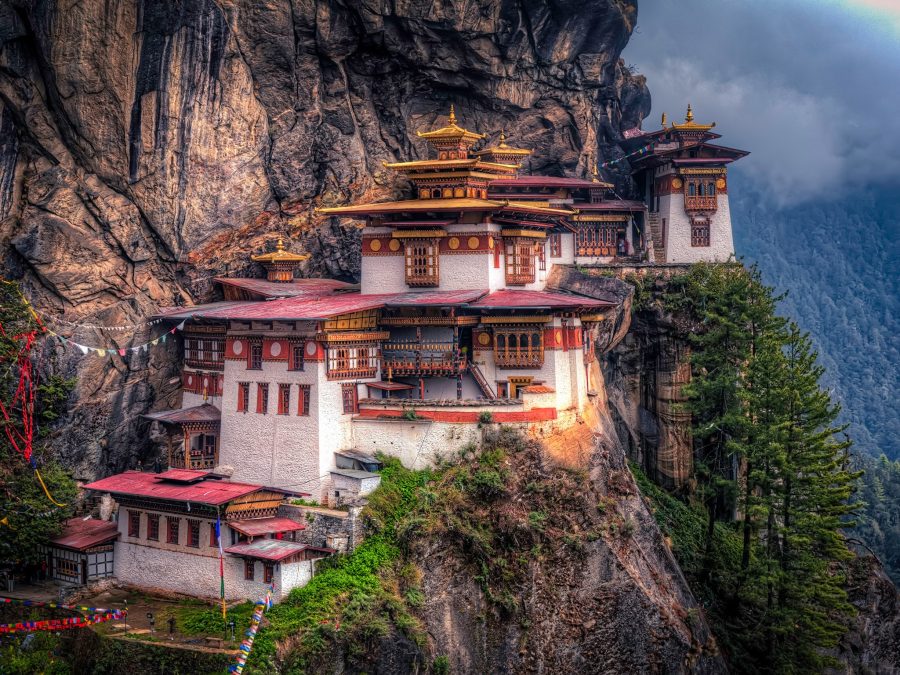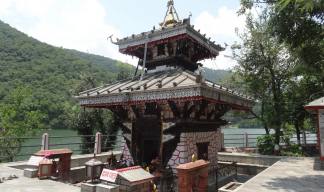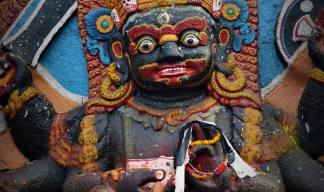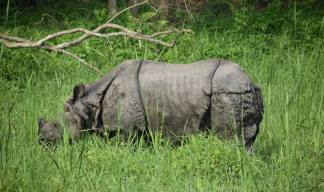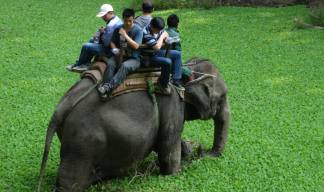Itinerary
Welcome to Kathmandu! Arrive at the Tribhuvan International Airport in Kathmandu.
Upon arrival you will be required to clear immigration and custom. After you clear customs you will be welcomed by a SITA
representative holding a paging board with your name(s) on it. You will be then escorted to your hotel.
Welcome and check-in on arrival at the hotel. Overnight at hotel in KATHMANDU
This morning you will be required to wake up early. You will be met by your guide in the lobby of the hotel. After a brief introduction you will be transferred to the airport to board the
mountain flight- a once-in-a-lifetime experience, and a chance to witness some of the highest peaks in the world including Mount
Everest from a plane. This is an exhilarating experience as the aircraft flies alongside the Himalaya to give you eye-level views of the
snow peaks like Langtang Lirung (7234M), Shisha Pangma (8013M), Dorje- Lakpa (6966M), Gauri Shankar (7134M), Melungtse (7181M),
Pumoki (7161M), Nuptse (7855M), Makalu 8463M, Lhotse (8516M) and finally, Sagarmatha (Everest 8848M). Cruising close to the
awesome massifs of rock and ice, the flight presents a mind-boggling sight. After the mountain flight you will drive back to hotel and proceed for breakfast. Later in the afternoon you will proceed for the visit of the Kathmandu Durbar Square. KATHMANDU DURBAR SQUARE: Durbar, which means palace, is where the kings were once crowned and where they ruled from.
Kathmandu has its Durbar Square at its heart; here charm of old town blends well with traditional architecture in a rich cultural
backdrop. The entire square was designated as UNESCO World Heritage Site in 1979. The massive complex consists of three main
squares, which is home to palaces, temples, and courtyard. Later you will embark on a thrilling rickshaw ride of around 30 minutes from Hanuman Dhoka till Thamel through narrow alleys and
observe the local life in Kathmandu from close range. Thamel becomes colorful & vibrant at this time of day with decorated shops with
handicrafts, curio, silver jewelleries, adventure gears and the list goes on. You will have some free time here to stroll around.SWAYAMBHUNATH: Perched on top of a conical hill is a white dome with glittering golden spire is visible from all sides of the valley
for many miles. This most ancient and enigmatic of all the holy shrines in Kathmandu Valley, Swayambhunath Stupa, is also known as
the Monkey Temple. PATAN DURBAR SQUARE: Just 5 km south of Kathmandu is Patan, the city of artistry, which is one of the three Royal cities in the
Valley. Connoisseurs of fine arts and architecture will be delighted with the city’s offering of various Buddhist and Hindu temples and
over 1000 monuments boasting of the finest wood and stone carvings. Later return to the hotel for dinner. Overnight at hotel in KATHMANDU
Buffet breakfast at the coffee shop. In the morning check-out of the hotel and leave for the airport for your onward flight to Pokhara. POKHARA is the third largest city in Nepal. It is the starting point for most of the treks in the Annapurna area. Pokhara is a remarkable
place of natural beauty, situated at an altitude of 827m from the sea level and 200km west of Kathmandu valley. It is considered by
many to be the most beautiful place. This enchanting city has several beautiful lakes and offers stunning panoramic views of
Himalayan peaks. The serenity of lakes and the magnificence of the Himalayas rising behind them create an ambience of peace and
magic. Pokhara spans 8 km from north to south and 6 km from east to west but, unlike Kathmandu, it is quite loosely built up and
still has much green space. On arrival, transfer to the hotel. Welcome and check-in on arrival. In the evening, get ready for an exciting boat ride on the Phewa Lake. PHEWA LAKE: The center of attraction in Pokhara is the Phewa Lake - the second largest lake in the country. It is the largest and
most enchanting of the three lakes that add to the resplendence of Pokhara. Here, one can sail or row a hired boat or visit the island
temple in the middle. The favorite home base for travelers is the eastern shore of the lake. Overnight at hotel in POKHAR
You will have an early start as you drive to Sarangkot (1500m) for a sunrise view this morning. You can enjoy the views of the
landscapes and mountains; observe local people, villages and farms. On a clear day, a panoramic view of the Himalaya could be seen
from here.After sunrise, you will drive back to hotel for breakfast. After breakfast you will drive to Phewa Power House for Damsadi Village Hike (07KM/15 minute drive).
From the parking area you will walk to a nearby bridge (Duration– 15 minutes).
Cross the bridge and walk through the small Damsadi village (Duration- 20 minutes). At the first view point, enjoy the sceneries of Pardi River, Annapurna, Manaslu Himalayan range and entire Pokhara valley (subject to
weather conditions). Proceed onwards to Ambot Village (950M) (a gentle ascending walk – approx. 30 minutes)
Reach the second view point, a fascinating view of Mt Annapurna and Mt. Dhaulagiri (subject to weather conditions). Later start downhill to Damsadi Bridge which is a suspension bridge measuring 224 m in length (approx. 20-minute descending). During the day visit the International Mountain Museum. INTERNATIONAL MOUNTAIN MUSEUM: This expansive museum is devoted to the mountains of Nepal, the mountaineers who climbed
them and the people who call them home. Inside, you can see original gear from many of the first Himalayan ascents, as well as
displays on the history, culture, geology, and flora and fauna of the Himalaya. Once you’ve been inspired by the climbers of the past,
head outside where there’s a 21m climbing wall and a 9.5m-high climbable model of Mt Manaslu. Overnight at hotel in POKHARA
After breakfast, take a short drive to Pokhara airport to board your flight to Chitwan, home to the Chitwan National Park. THE CHITWAN NATIONAL PARK: The Chitwan National Park lies in the Inner Terai lowlands and consists of Sal forests, tall elephant
grasslands, hills, ox-box lakes and flood plains of the Narayani, Rapti and Reu rivers. Enlisted as a UNESCO World Heritage Site
(Natural) in 1984, the park spreads over an area of 932 sq.km. The park is home to 56 species of mammals, 49 species of amphibians
and reptiles, and 525 species of birds. Wildlife found here include endangered species like the one-horned rhinoceros and the Royal
Bengal tiger, gaur, wild elephant, four-horned antelope, leopard, sloth bear, wild boar, rhesus monkey, grey langur monkey, wild
dog, small wild cats, and many other smaller animals. Also found here are cobras, kraits and pythons.Arrive at Barahi Jungle Lodge via Chaubiskothi, which is 32 K.M. from the main highway in Bharatpur. Upon arrival, welcome drink will
be served, followed by a short briefing on the program and the facilities rooms will be assigned. In the afternoon you will proceed for a boat safari down the Rapti river, towards the western boundary of the park. At the point of
confluence of the Rapti and Narayani rivers, you will de-board in order to experience a perfect sundowner. Dinner at the Banyan Café or by the pool. Overnight at hotel in CHITWAN
Morning Jeep Safari with breakfast in the jungle (Duration: approx. 4-5 Hours). Proceed for the Jeep Safari crossing the Rapti River by Patela Boat to start from the Bhimle army check-post.
There are two choices of routes available at the park. The accompanying naturalists pick the best route depending on their experience
of most recent sightings and animal movements. Breakfast will be served in between the safari in a scenic and safe spot chosen by the Naturalist. (Note: Jeep Safari is prohibited during
monsoon season by the park authorities from June-September and in some season it can prolong till October) After safari you can have time at leisure to relax by the pool or use of spa facilities until it is time for lunch. During the second half of the day you will be able to take a walk into the jungle. WALKING SAFARI: A walk inside the National park accompanied by an experienced naturalist and nature guide to explore the wildlife,
flora & fauna and birding. In the evening, you will be treated to an outstanding native dance form- the Tharu dance, performed by the local Tharu community.
Enjoy a local authentic dinner while you watch this beautiful dance form. THARU CULTURAL DANCE: In the Terai region bordering both India and Nepal, the Tharus form an indigenous group of settlers
involved in farming and traditional crafts. The Tharu dance forms an important event in the life of this ethnic community and is
performed on special occasions, usually around festivals related to harvests. It is a time for feasting, drinking and merry-making. Overnight at the resort in CHITWAN
Day 7
Fly to Kathmandu & drive to Dhulikhel
You will rise early to take your flight to Kathmandu and later drive to Dhulikhel while you visit Bharatpur Durbar Square en-route.BHAKTAPUR DURBAR SQUARE: Name of Bhaktapur literally translates to ‘City of devotees’. The best preserved of the three main
medieval cities of the valley, Bhaktapur comprise some of the most breathtaking religious architecture in the entire country. It has
three major squares, Durbar Square, Taumadhi Square, and Dattatreya Square; studded with pagoda and shikhara-style temples.
Devoid of traffic and pollution, Bhaktapur by far is definitely the cleanest city in the Valley. Narrow stone paved streets snake
through red brick houses, leading you to hidden temples, water sprouts, and courtyards. The city proudly displays its cultural life
through daily lifestyle; artisans have been continuing traditional works like weaving, pottery, and wooden work for generation and
you can catch skillful people busy with their work on the roadsides. Locals gather in the communal courtyard to bathe, collect water,
do their laundry, and some to just socialise. Bhaktapur is known for its cultural handicrafts such as pottery, puppets, and masks, it is
the perfect place to shop if you want light and easy-to-carry souvenirs. Main attractions of this city are 55 Window Palace, Golden
Gate, Lion’s Gate, Mini Pashupati Temple, Nyatapola Temple, and BhairavNath Temple, among others. When you get tired of the walk
around this mesmerising city, enjoy the delicious Juju Dhau ‘King’s curd’ for some needed refreshment. Later drive to Dhulikhel.DHULIKHEL Popular among the traders, Dhulikhel was one of the most well-known markets along the Nepal and Tibet trade route. The old city
still has the medieval charm. The old city is believed to be inhibited for last five centuries. Similar to many other small towns around
the Valley, Dhulikhel too is a Newari settlement. The place is known for the mesmerizing view of the Himalayan range, green and
beautiful picnic spots, and temples of various deities. One can find both Hindu temples and Buddhist stupas in and around the old
city. The place also has various small guest houses and exclusive resorts for yoga and other wellness and lifestyle services.Overnight at resort in DHULIKHEL
Day 8
Fly from Kathmandu to Paro & drive to Thimphu
After breakfast drive back to Kathmandu and later proceed to the international airport to catch your connecting flight to Paro.
Your journey begins with the most spectacular mountain flight with views of major Himalayan peaks such as Everest, Kanchenjunga and
Makalu, and on the final approach Bhutan’s own snowy peaks, the sacred Jhomolhari, Jichu Drake and Tserimgang. You fly over the
southern hills, known as the ‘dwars’, or gateways into the Himalayas as they rise from the plains until they meet the great snow�capped peaks that rise up to the sky. On arrival at Paro airport and after completion of airport formalities, you will be met by your representative (guide). Drive from Paro
to Thimphu, the modern capital town of Bhutan and an exciting blend of tradition and modernity. Rest of the day at leisure or you may want to take a stroll through this lively town. In the evening, time permitting, visit the impressive TRASHICHO DZONG/FORTRESS which houses the throne room of the King and
various government offices. It is also the summer residence of the Chief Abbot and the central monk body. If your visit falls on a
working weekday, arrive in time to watch the hoisting of the National Flag and the March of the Guards. (Open: Mon-Fri [Mar-Oct after
5:30pm] [Nov-Feb after 4:30 pm] / Open on Sat, Sun, Govt. Holidays) Overnight at resort in THIMPHU
THIMPHU, perhaps the most unusual capital city in the world, is the seat of government. This bustling town is home to Bhutan’ s royal
family, the civil service, and foreign missions with representation in Bhutan. It is also the headquarters for a number of
internationally funded development projects. Today you will visit Buddha Dordenma statue sitting on top of a hill overlooking Thimphu. The Statue of Sakyamuni Buddha is one of
the tallest in Asia (51.5 m). The site of Buddha Dordenma offers unobstructed views over the capital town. (Closes Daily Nov-Feb at
4pm & Mar-Oct at 5pm). Gagyel Lhundrup Weaving Centre: Weaving is predominantly a woman’s domain but this private weaving center is different as it is
owned and run by Mr. Kesang (a man - which is very rare in Bhutan). He weaves, creates new and unique patterns, comes up with
unusual color combinations and is very involved. The center frequently produces ceremonial textiles for Bhutanese royals, including
the traditional outfit for King Jigme Khesar Namgyel Wangchuck and Queen Jetsun Pema's highly publicized October 2011 marriage. MEMORIAL CHORTEN, the building of this landmark was originally envisaged by Bhutan’s third king, His Majesty Jigme Dorji
Wangchuck, who had wanted to erect a monument to world peace and prosperity. Completed in 1974 after his untimely death, it is
both a memorial to the Late King (“the father of modern Bhutan”), and a monument dedicated to peace. During the mornings and
evenings, it a bustling place where people of all ages circumambulate the chorten/stupa, pray and prostrate at the shrine, turn the
big prayer wheels, offer butter lamps, bask in the sun as they socialize and mingle.(Closes Daily Nov-Feb at 4pm & Mar-Oct at 5pm). ZORIG CHOSUM, (also known as the painting school) offers a six year course in the 13 traditional arts and crafts of Bhutan. The
students follow a comprehensive course that starts with drawing and progresses through painting, woodcarving, embroidery and
statue-making. This is a great opportunity to interact and photograph the students while they practice their skills in the classroom.
(Closed on Sat 1pm, Sun, Govt. Holidays, School Break Jul, Jan-Feb). NATIONAL LIBRARY: The National Library was established in the late 1960s primarily to conserve the literary treasures which form a
significant part of Bhutan’s cultural heritage. It now houses an extensive collection of Buddhist literature mostly in block-printed
format, with some works several hundred years old. This collection, known as the Choekey Collection, mainly comprises Buddhist
literature written in Choekey, the religious script of Northern Buddhism, but also includes works written in Tibetan and in Dzongkha,
Bhutan’s national language. TRADITIONAL HANDMADE PAPER FACTORY, witness the process from start to finish. The paper is made from the barks of the black
Daphne tree. The thicker paper is used for scriptures and the thinner ones are used for wrapping gifts and various other purposes.
In the evening, take a stroll along the town’s main street. Overnight at hotel in THIMPHU
Drive over the high mountain pass of Dochu La Pass (3,050m) where on a clear day, there is a panoramic view of the towering
Himalayan peaks. The pass is marked by 108 stupas built by the Queen Mother. On a clear day you will be able to see the snow-capped
Himalayan range from here. PUNAKHA is located in a sub-tropical valley with warm summers and pleasant winters. Punakha served as the capital of Bhutan until
1955, when the seat of government moved to Thimphu. On arrival, visit CHHIMI LHAKHANG (TEMPLE), a 30-40 minute gradual walk through a village and paddy fields. Situated on a hillock
below the village of Metshina, the temple is dedicated to Lama Drukpa Kuenley (also known as the Divine Madman). The temple is
popular among women who have difficulties conceiving children. Later visit PUNAKHA DZONG (fortress), which is strategically built at the junction of the Pho Chu (male) and Mo Chu (female) river.
Damaged over the centuries by four catastrophic fires and an earthquake, the dzong/fortress has been fully restored to its former
glory. Punakha Dzong is one of the most beautiful fortresses in Bhutan. (Open 11am-1pm & 3pm-5 pm)
Rest of the day is at leisure. Overnight at hotel in PUNAKHA
After breakfast proceed to Paro crossing over Dochu-la Pass.
Continue to Paro. PARO This beautiful valley encapsulates a rich culture, scenic beauty and hundreds of myths and legends. It is home to many of Bh utan’s
oldest temples and monasteries and the country’s only airport. Mt. Jhomolhari (7,300m) reigns in white glory at the northern end of
the valley, its glacial waters plunging through deep gorges to form the Pa Chu (Paro River). The Paro valley is one of the kingdom’s
most fertile, producing the bulk of Bhutan’s famous red rice from its terraced fields. In Paro, visit KICHU LHAKHANG one of the oldest temples in the country. The temple is one of the 108 temples built in the Himalayas
by the Tibetan king, Songtsen Gampo to subdue a demoness in the 7th century. The building of this temple marks the introduction of
Buddhism in Bhutan. Then proceed to visit the NATIONAL MUSEUM. The museum collection includes ancient Bhutanese art and artifacts, weapons, coins,
stamps and a small natural history collection. (Closed on Govt. Holidays)End the day with a visit to a Farmhouse to share a cup of traditional butter tea with the family. Overnight at hotel in PARO
Today you will embark on an excursion to view the spectacular and famous Taktsang monastery (the Tiger’s Nest). The trail to the monastery climbs through beautiful pine forest with many trees festooned with Spanish moss and the occasional grove
of fluttering prayer flags. The hike will take you past a small cafeteria if a break is needed. TAKTSANG MONASTERY: Built in 1600’s, this incredible monastery clings to the edge of a sheer rock cliff that plunges 900 meters
into the valley below. It is believed that, in the 8th century Guru Rimpoche, the tantric mystic who brought Buddhism to Bhutan,
landed here on the back of a flying tigress to subdue a demon. Guru Rimpoche is believed to have meditated here for three months
and this place is considered as a ‘Mecca’ for Buddhists. Lunch will be served at the cafeteria. After the hike, you will visit Dungtse Lhakhang. The uniqueness of this temple lies in the fact
that it is in the form of a chorten, one of the very few that exists in Bhutan. The lhakhang was built in 1421 by the famous Tibetan
lama, Thongten Gyelpo (1385-1465) who was also known as Changzampa or the builder of iron bridges. It is believed that a demoness
was terrorizing the Paro valley and the very hill that the temple is built on turned out to be the demoness’s head. So he built a chorten
shaped temple over the demoness’s head or the hills to overpower her, as chortens most of the time play the part of a nail that
immobilizes a demon. This evening, once back to your hotel, you can take a leisurely guided walk of the town of Paro. Your guide will demonstrate and
explain the details of the game using the traditional bamboo bow and arrow. You can enjoy a few rounds of archery practice. Archery
is the national sport of Bhutan. Spectators marvel at the dexterity of the Bhutanese and gasp at other members of a team who stand
close to the target and sidestep the flying arrows. The traditional bows and arrows are made from bamboo. There are 2 painted targets
placed at each end of the range at about 120 meters apart. Two teams of 11 archers compete, each player shoots two arrows and the
first team to get 33 points wins the match. The method of scoring is a little complicated. The best archers wear multi coloured scarves
tied to the back of their belts. Each time an arrow hits the bulls eye a short victory dance is performed by the team. Overnight at hotel in PARO
This morning, after a leisurely breakfast at the hotel, complete your checkout formalities by noon to head back to Paro airport. On arrival, you will be dropped at the international airport for your international flight.
